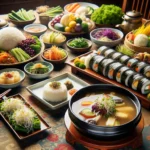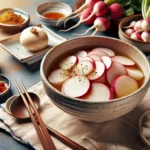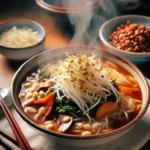Imagine a steaming bowl of authentic Korean kimchi soup, or Kimchi Guk, nestled in front of you, its vibrant colors inviting your senses. This dish not only warms your body but also tells a rich story of tradition, flavor, and health. As you embark on this culinary adventure, prepare to uncover the essential ingredients and techniques that transform simple components into a masterpiece. Do you feel the excitement? Let’s dive into the world of Kimchi Guk, where each sip not only delights your palate but also celebrates the wonderful benefits of kimchi itself.

Ingredients for a Traditional Kimchi Soup
To create an authentic Korean Kimchi Soup, or Kimchi Guk, it’s essential to gather the right ingredients! Each component adds a unique layer of flavor and nutrition, resulting in a hearty dish that’s perfect for any occasion. ✨ Here’s a comprehensive list of what you’ll need to embark on your culinary adventure:
Main Ingredients
- Kimchi (2 cups): The star of the dish! Well-fermented kimchi, packed with flavor, provides that deep, tangy taste. Depending on your preference, you can choose between napa cabbage kimchi or radish kimchi, but the quality and age of the kimchi will profoundly influence the final soup. Freshly made kimchi tends to be less sour, while the aged version boasts a stronger flavor profile. 😋
- Pork Belly or Beef (200g): For a rich and savory broth, traditional recipes often incorporate pork belly or beef. Thinly sliced, this meat will lend its umami essence to the soup. If you prefer a vegetarian version, tofu can be a fantastic substitute, offering protein while remaining light! 🌱
- Water or Broth (4 cups): The foundation of your soup! Using water works fine, but a good-quality chicken or meat broth can elevate the flavor immensely. For a vegan option, vegetable broth can serve as an excellent base. Aim for something flavorful as this will be the main liquid in your dish.
- Garlic (4 cloves, minced): Garlic adds an aromatic depth to your soup, enhancing the overall flavor. Fresh garlic cloves, minced, bring a bright and zesty taste that binds all the flavors together.
- Ginger (1-inch piece, minced): This adds a hint of spice and warmth! Minced ginger introduces warmth to the soup and complements the flavors of the kimchi beautifully, providing complexity to the dish.
- Spring Onions or Green Onions (2-3 stalks, chopped): These not only add a pop of green color but also elevate the aroma and texture of the soup. Wouldn’t it be delightful to see those vibrant greens floating in your bowl? 🌿
- Sesame Oil (1 tablespoon): Just a drizzle can go a long way! This oil brings nuttiness and depth, enhancing the overall flavor. A touch of sesame oil just before serving will elevate your dish to gourmet levels!
- Gochugaru (Korean Red Pepper Flakes) (1 tablespoon) or Gochujang (Korean Red Pepper Paste) (1 tablespoon): For those who enjoy a bit of heat, you might want to include these spicy ingredients. Gochugaru offers a smoky flavor, while gochujang adds a slight sweetness along with spiciness. Adjust these based on your heat tolerance! 🔥
- Soy Sauce (1-2 tablespoons): This adds the much-loved umami flavor to the broth, balancing out the sourness of the kimchi.
- Tofu (optional, 200g): If you’re opting for a more filling and nutritious soup, don’t forget the tofu! Silken or firm, cubed tofu can bring a delightful texture that complements the tanginess of the kimchi.
- Salt and Pepper: Seasoning to taste! After tasting your soup, a pinch of salt and a dash of black pepper can enhance the overall flavors.
- Optional Ingredients: Mushrooms (like shiitake or enoki), zucchini, or other vegetables can also be included for extra nutrition and variety! Just think about the textures and flavors that might work well with your kimchi soup! 🍄🥒
With these ingredients gathered, you’ll be fully equipped to create a traditional Kimchi Soup that’s not only rich in flavor but full of warmth and comfort. Each ingredient is a building block, culminating in a simply delicious bowl of heartfelt goodness! Enjoy the process of cooking and creating something truly special! 🌟
Step-by-Step Cooking Instructions
Creating a perfect Korean Kimchi Soup (Kimchi Guk) requires both precision and passion! Let’s dive into the step-by-step process that transforms simple ingredients into a delightful bowl of warmth. 🌶️🍲
1. Prepare Your Ingredients:
Before you commence cooking, ensure all ingredients are ready and at hand. You will need approximately 2 cups of fermented kimchi, 1 cup of pork belly or tofu as a vegetarian option, 4 cups of water or dashi stock for added umami, 1 tablespoon of gochugaru (Korean red pepper flakes) to bring the heat, and seasonings like soy sauce and garlic. Don’t forget a sprinkle of scallions for garnish! ✅
2. Sauté the Base:
In a pot over medium heat, drizzle about 1 tablespoon of vegetable oil. Once it shimmers, add your chopped pork belly and sauté for around 5-7 minutes until it’s nicely browned and its flavorful oils have begun to render. If you’re opting for tofu, lightly fry it until golden before proceeding. The goal is to build a rich flavor base. Let’s get aromatic! 😋
3. Add the Aromatics:
Next, introduce minced garlic (about 3 cloves) and a little ginger (1 teaspoon), stirring for approximately 1 minute until fragrant. The enticing aroma will surely tickle your senses! Now, it’s time for the star of the dish—add your kimchi! Stir it in and cook until it softens, about another 5 minutes. Did you know that the longer you cook kimchi, the deeper its flavor becomes?! Talk about depth! 🌟
4. Pour in the Liquid:
Now that the base is ready, add your 4 cups of water or dashi stock. Feel free to adjust based on your desired thickness. Bring it to a gentle boil. Once boiling, toss in 1 tablespoon of gochugaru and a dash of soy sauce (about 2 tablespoons). Lower the heat, allowing it to simmer for 15-20 minutes. This step is crucial as it lets all those wonderful flavors meld together. Oh, the anticipation! ⏳
5. Taste and Adjust Seasoning:
After simmering, taste your soup. Does it need more spice? Perhaps a pinch of salt or a splash of soy sauce? This is your canvas—make it to your liking! For those who enjoy a bit of tang, a splash of vinegar can brighten it up beautifully. 💖
6. Finish Up with Tofu and Scallions:
If you have yet to add tofu, do so now and simmer for an additional 5 minutes to merge the flavors. Just before serving, toss in chopped scallions to add that fresh crunch. They also enhance the visual appeal—texture and color matter in our culinary adventures! 🌈
7. Serve and Savor:
Ladle the steaming soup into bowls, making sure to include juicy bits of kimchi and meat or tofu. For a final touch, you can sprinkle a little more gochugaru on top for that extra kick and garnish with sesame seeds. Pair with steamed rice and perhaps some side dishes (banchan) for a truly authentic experience! 🌾
This step-by-step guide should equip you with the confidence to whip up a delicious pot of Kimchi Guk. The aroma wafting through your kitchen and the warmth filling your belly will surely make this a recurrent dish in your home! Each spoonful will tell a story of tradition, flavor, and health. Keep this recipe close and enjoy the journey of cooking. Happy cooking!
Tips for Perfecting Your Kimchi Guk
To truly master the art of making Kimchi Guk, several key considerations can elevate it from a simple dish to a vibrant culinary experience that warms the heart and soul. 🌶️ First and foremost, selecting the right kimchi is essential. Aged kimchi, ideally fermented for 2-3 weeks, will offer a depth of flavor that young kimchi simply can’t match. The fermentation process enhances the umami characteristics, adding that special zing to every spoonful! 😋
The Importance of Broth
Next, don’t skimp on the broth! Using a homemade anchovy or kelp stock can significantly elevate the taste profile of your soup. For every 1 liter of water, consider adding around 10 dried anchovies or a piece of kelp (about 15 cm long). The resulting stock should simmer for at least 20 minutes to extract those rich flavors—this is a non-negotiable step! 🐟🌊
Ingredient Sequence
Moreover, the sequence of adding ingredients can impact the overall harmony of the dish. Start by sautéing aromatic ingredients like garlic and ginger in a bit of oil before adding kimchi. This method not only releases the rich aromas but also ignites the base flavor, allowing the kimchi to caramelize slightly for that perfect burst of flavor! 🌟
Protein Options
For protein lovers, consider adding cubed firm tofu or bite-sized chunks of pork belly. If you’re using pork, sear it well before adding other ingredients to give the broth an added depth of savoriness. Interestingly, a 100g serving of pork belly can bring in approximately 300 calories and 25g of protein, giving your dish a nutritious boost! 🍖🥢
Seasoning Tips
Seasoning should not be overlooked either. Instead of relying solely on salt, mix it up with a dash of fish sauce (1 tablespoon should suffice) or a splash of soy sauce for added complexity. This may sound simple, but it creates layers of flavor that’ll keep your diners guessing! 🧂
Spice It Up
An optional yet delightful twist! Try adding a little bit of Korean chili flakes (gochugaru) or fresh chilis to kick it up a notch! A teaspoon or two can dramatically change the spice level, taking the overall experience to a climactic finish. 🌶️✨
Garnishing
Don’t forget the final touch—garnishing! A sprinkle of green onion, sesame seeds, and maybe a dollop of sesame oil right before serving can transform your Kimchi Guk into a dish that not only tastes heavenly but looks mesmerizing as well! Just imagine your guests’ eyes lighting up at the presentation! 🍜💚
Time Management
Time management is also key. The entire process can take about 40-60 minutes, so pace yourself to allow the flavors to meld beautifully. And remember, letting it simmer slightly longer can create a richer broth—don’t be afraid to experiment a bit. Each chef has their own unique style, and so should your Kimchi Guk!
Serving Suggestions
Lastly, serve it hot, ideally with a bowl of steamed rice on the side, to soak up all that delicious broth. This pairing creates a harmonious balance, complementing the spiciness and tanginess of the soup. Your guests will certainly savor each bite while appreciating the time and love you put into perfecting this beloved dish! 🍚❤️
Mastering Kimchi Guk is a delightful journey. With these tips at hand, your creation will be bursting with flavors and sure to impress! Enjoy the adventure! 🎉
Health Benefits of Kimchi Soup
Kimchi soup, or Kimchi Guk, isn’t just a tantalizing comfort food; it’s also packed with an abundance of health benefits that can delight and nourish the body at the same time! 🍲 Did you know that this traditional Korean dish is an excellent source of probiotics, vitamins, and antioxidants? Let’s dive into the amazing health advantages that Kimchi soup brings to the table – literally!
The Probiotic Power
First and foremost, kimchi – the star ingredient – is made from fermented vegetables, notably napa cabbage and radishes, which offer a treasure trove of probiotics. These friendly bacteria can significantly improve gut health by promoting digestion and enhancing the gut microbiome. Research indicates that a healthy gut can enhance immune function: did you know that nearly 70% of the immune system is housed in the gut? 🌿
Digestion and Comfort
Furthermore, consuming kimchi soup can lead to improved digestion and can combat issues such as bloating and constipation. Those who struggle with an upset stomach may find solace in a warm bowl of this nourishing soup, as the probiotics help break down food and reduce gastrointestinal discomfort. Isn’t that a great reason to keep a pot on your stove? 😉
Vitamin Richness
Let’s not overlook its wealth of vitamins! Kimchi is rich in vitamins A, B, and C, which are crucial for maintaining healthy skin, energy levels, and immune function. Just one serving of kimchi can provide approximately 50% of your Daily Value (DV) for vitamin C! This antioxidant powerhouse works wonders, not only for boosting your immune system but also for promoting collagen synthesis, keeping your skin radiant and youthful. 🌟
Capsaicin Benefits
Moreover, the chili pepper commonly used in kimchi – often a staple in Kimchi Guk – contains capsaicin, a compound known for its metabolism-boosting properties. It’s believed that capsaicin may help in weight management by enhancing fat oxidation and decreasing appetite! How’s that for a spicy twist on your meal plan? 🌶️ With such caloric benefits, indulging in Kimchi Guk can be guilt-free, as it efficiently combines pleasure with purpose.
Hydration and Weight Management
In addition, Kimchi soup is hydrating and low in calories, making it a great option for those looking to maintain or lose weight. With a typical serving containing around 100 calories, it becomes a guiltless choice in comparison to many other hearty soups that can sometimes tip the scales. Plus, it can be easily tailored: feel free to add more vegetables or protein to the mix for added nutrients! 🥦🍗 The versatility of Kimchi Guk is endless, delivering rich taste while supporting your health goals.
Antioxidants for Vision
For individuals using a plant-based diet, Kimchi also supplies essential antioxidants such as beta-carotene, lutein, and zeaxanthin, aiding vision and skin health. Could something so delicious be packed with so many nutrients? Absolutely! By including that bowl of Kimchi Guk in your weekly meal rotation, one can experience an upsurge in overall wellness.
Mindful Sodium Intake
On the flip side, it’s essential to be mindful of sodium levels if you’re watching your salt intake. Some commercial kimchi products can be high in sodium due to the fermentation process. However, making your own kimchi or choosing lower-sodium options enables everyone to fully enjoy this delight without overdoing it! 🍽️
Cultural Significance
The health benefits of Kimchi Guk are further amplified when paired with its cultural significance. Traditional Korean medicine often emphasizes the balance between food and health, and Kimchi is heralded as a superfood that embodies this philosophy. By enjoying this dish, one not only relishes a burst of flavor but also honors the rich history of healthy eating! 🤗
Conclusion
In conclusion, the multifaceted benefits of Kimchi soup stretch far beyond its satisfying taste. It rehabilitates the gut, enhances skin quality, fuels energy, assists in weight management, and upholds a cultural legacy of well-being. 🌏 So why not indulge in a comforting bowl today? Your body will thank you!
As you savor your homemade kimchi soup, let it serve as a reminder of the beauty in tradition and the warmth of shared meals. Each spoonful is an invitation to explore the rich tapestry of flavors and health benefits woven into this beloved dish. Don’t just stop at following a recipe; make it your own. Experiment with spices, add your favorite proteins, or perhaps even a twist of citrus for brightness. The journey of creating kimchi guk is as delightful as the meal itself. So gather your loved ones, dive into the process, and relish not just the dish but the memories created around it. Happy cooking!













